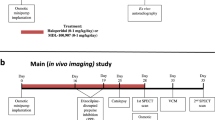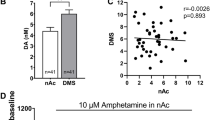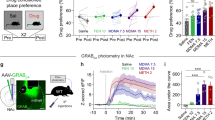Abstract
The combination of M100907, a putative antipsychotic drug (APD) and serotonin (5-HT)2A antagonist, and the typical APD haloperidol, can enhance dopamine (DA) release in rat medial prefrontal cortex (mPFC), an effect which has been postulated to be of value to improve cognition and negative symptoms. The present study demonstrated that another putative APD and 5-HT2A/2C antagonist, SR46349-B (10 mg/kg, but not 1–3 mg/kg) alone, but not M100907 (0.1 and 3 mg/kg) alone, increased mPFC DA release, whereas neither drug alone affected nucleus accumbens (NAC) DA release. Neither SR46349-B nor M100907 alone affected nucleus accumbens (NAC) DA release. Neither SR46349-B nor M100907 alone affected nucleus accumbens (NAC) DA release. SR46349-B (3 mg/kg) potentiated haloperidol-induced DA release in both regions, whereas M100907 (0.1 mg/kg) potentiated haloperidol (0.1 mg/kg)-induced mPFC DA release and inhibited it in the NAC. WAY100635 (0.2 mg/kg), a 5-HT1A antagonist, abolished the effects of haloperidol plus M100907 as well as SR46349-B on DA release in the mPFC, but did not do so in the NAC. Thus, 5-HT2A and 5-HT2A/2C antagonism together with haloperidol-induced D2 antagonism may potentiate mPFC DA release via 5-HT1A agonism, whereas the combined effects of these agents on NAC DA release is not dependent upon 5-HT1A receptor stimulation. Interestingly, similar to the effect of SR46349-B, high dose M100907 (3 mg/kg), which might have antagonist activity at 5-HT2C receptors, potentiated 1 mg/kg haloperidol-induced DA release in the mPFC and NAC. These results suggest that 5-HT2A/2C antagonism may be more advantageous than selective 5-HT2A antagonism as an adjunct to D2 antagonists to improve cognition and negative symptoms in schizophrenia.
Similar content being viewed by others
Log in or create a free account to read this content
Gain free access to this article, as well as selected content from this journal and more on nature.com
or
References
Andersson JL, Nomikos GG, Marcus M, Hertel P, Mathe JM, Svensson TH . (1995): Ritanserin potentiates the stimulatory effects of raclopride on neuronal activity and dopamine release selectivity in the mesolimbic dopaminergic system. Naunyn-Schmiedebergs Arch Pharmacol 352: 374–385
Appel NM, Mitchell WM, Garlick RK, Glennon RA, Teitler M, De Souza EB . (1990): Autoradiographic characterization of (±)-1-(2,5-dimethoxy 4-[125I]iodophenyl)-2-aminopropane([125I]DOI) binding to 5-HT2 and 5 HT1C receptors in rat brain. J Pharmacol Exp Ther 255: 843–857
Barnes NM, Sharp T . (1999): A review of central 5-HT receptors and their function. Neuropharmacol 38: 1083–1152
Bymaster FP, Shannon HE, Rasmussen K, DeLapp NW, Ward JS, Calligaro DO, Mitch CH, Whitesitt C, Ludvigsen TS, Sheardown M, Swedberg M, Rasmussen T, Olesen PH, Jeppesen L, Sayerberg P, Fink-Jensen A . (1999): Potential role of muscarinic receptors in schizophrenia. Life Sci 64: 527–534
[conf] Carr AA, Hay DD, Dudley MW, Kehne JH, Nieduzak TR . (1991): MDL 28,133A and related α-aryl-4-piperradinyl methanols and ketones as potent and selective inhibitors of serotonin 5-HT2 receptors. Abstracts of the III International Congress on Schizophrenia Research, Tucson, AZ
Davis KL, Kahn RS, Grant K, Davidson M . (1991): Dopamine in schizophrenia: a review and reconceptualization. Am J Psychiat 148: 1474–1486
De Deurwaerdère P, Spampinato U . (1999): Role of serotonin2A and serotonin2B/2C receptor subtypes in the control of accumbal and striatal dopamine release elicited in vivo by dorsal raphe nucleus electrical stimulation. J Neurochem 73: 1033–1042
Dewey SL, Smith GS, Logan J, Brodie JD, Fowler JS, Wolf AP . (1993): Striatal binding of the PET ligan 11C-raclopride is altered by drugs that modify synaptic dopamine levels. Synapse 13: 350–356
Di Giovanni G, De Deurwaerdère P, Di Mascio M, Di Matteo V, Esposito E, Spampinato U . (1999): Selective blockade of serotonin-2C/2B receptors enhances mesolimbic and mesostriatal dopaminergic function: a combined in vivo electrophysiological and microdialysis study. Neurosci 91: 587–597
Di Giovanni G, Di Matteo V, Di Mascio M, Esposito E . (2000): Preferential modulation of mesolimbic vs. nigrostriatal dopaminergic function by serotonin2C/2B receptor agonists: a combined in vivo electrophysiological and microdialysis study. Synapse 35: 53–61
Di Matteo V, Di Giovanni G, Di Mascio M, Esposito E . (1999): SB 242084, a selective serotonin2C receptor antagonist, increases dopaminergic transmission in the mesolimbic system. Neuropharmacol 38: 1195–1205
Di Matteo V, Di Mascio M, Di Giovanni G, Esposito E . (2000a): Acute administration of amitriptyline and mianserin increases dopamine release in the rat nucleus accumbens: possible involvement of serotonin2C receptors. Psychopharmacol 150: 45–51
Di Matteo V, Di Giovanni G, Di Mascio M, Esposito E . (2000b): Biochemical and electrophysiological evidence that Ro 60–0175 inhibits mesolimbic dopaminergic function through serotonin2C receptors. Brain Res 865: 85–90
Di Matteo V, De Blasi A, Di Giulio C, Esposito E . (2001): Role of 5-HT2C receptors in the control of central dopamine function. Trends Pharmacol Sci 22: 229–232
Gobert A, Millan MJ . (1999): Serotonin (5-HT)2A receptor activation enhances dialysis levels of dopamine and noradrenaline, but not 5-HT, in the frontal cortex of freely-moving rats. Neuropharmacol 38: 315–317
Gobert A, Rivet J-M, Lejeune F, Newman-Tancredi A, Adhumeau-Auclair A, Nicolas J-P, Cistarelli L, Melon C, Millan MJ . (2000): Serotonin2C receptors tonically suppress the activity of mesocortical dopaminergic and adrenergic, but not serotonergic, pathways: A combined dialysis and electrophysiological analysis in the rat. Synapse 36: 205–221
Goff DC, Amico E, Dreyfuss D, Ciraulo D . (1995): A placebo-controlled trial of trihexyphenidyl in unmedicated patients with schizophrenia. Am J Psychiat 151: 429–431
Hall H, Farde L, Halldin C, Lundkvist C, Sedvall G . (2000): Autoradiographic localization of 5-HT2A receptors in the human brain using [3H]M100907 and [11C]M100907. Synapse 38: 421–431
Hertel P, Fagerquist MV, Svensson TH . (1999): Enhanced cortical dopamine output and antipsychotic-like effects of raclopride by α2 adrenoceptor blockade. Science 286: 105–107
Hicks PB, Browning J, Barwick S, Jones D, Wadenberg M-L, Richter JT, Young KA . (1999): M100,907 acts both the nucleus accumbens and the prefrontal cortex to mediate the enhancement of the suppression of conditioned avoidance response by haloperidol. Schizophr Res 36: 115
Ichikawa J, Meltzer HY . (1999a): Relationship between dopaminergic and serotonergic neuronal activity in the frontal cortex and the action of typical and atypical antipsychotic drugs. Eur Arch Psychiat Clin Neurosci 249(Suppl 4): S90–S98
Ichikawa J, Meltzer HY . (1999b): R(+)-8-OH-DPAT, a serotonin1A receptor agonist, potentiated S(-)-sulpiride-induced dopamine release in rat medial prefrontal cortex and nucleus accumbens but not striatum. J Pharmacol Exp Ther 291: 1227–1232
Ichikawa J, Meltzer HY . (2000): The effect of serotonin1A receptors on antipsychotic drug-induced dopamine release in rat striatum and nucleus accumbens. Brain Res 858: 252–263
Ichikawa J, Ishii H, Bonaccorso S, O'Laughlin IA, Fowler WL, Meltzer HY . (2001a): 5-HT2A and D2 receptor blockade increases cortical DA release via of 5-HT1A receptor activation: a possible mechanism of atypical antipsychotic-induced cortical dopamine release. J Neurochem 76: 1521–1531
Ichikawa J, Dai J, Meltzer HY . (2001b): DOI, a 5-HT2A/2C receptor agonist, attenuates clozapine-induced cortical dopamine release. Brain Res 907: 151–155
Ichikawa J, Dai J, O'Laughlin IA, Fowler WL, Meltzer HY . (2002): Atypical, but not typical, antipsychotic drugs increase cortical acetylcholine release without an effect in the nucleus accumbens or striatum. Neuropsychopharmacology 26: 325–339
Kehne JH, Baron BM, Carr AA, Chaney SF, Elands J, Feldman DJ, Frank RA, Van Giersbergen PLM, Mccloskey TC, Johnson MP, Maccarty DR, Poirot M, Senyah Y, Siegel BW, Widmaier C . (1996): Preclinical characterization of the potential of the putative atypical antipsychotic MDL 100,907 as a potent 5-HT2A antagonist with a favorable CNS safety profile. J Pharmacol Exp Ther 277: 968–981
Kuroki T, Meltzer HY, Ichikawa J . (1999): Effect of antipsychotic drugs on extracellular dopamine levels in rat medial prefrontal cortex and nucleus accumbens. J Pharmacol Exp Ther 288: 774–781
Li X-M, Perry KW, Wong DT, Bymaster FP . (1998): Olanzapine increases in vivo dopamine and norepinephrine release in rat prefrontal cortex, nucleus accumbens and striatum. Psychopharmacol 136: 153–161
Liégeois J-F, Ichikawa J, Meltzer HY . (2002): 5-HT2A receptor antagonism potentiates haloperidol-induced dopamine release in rat medial prefrontal cortex and inhibits that in the nucleus accumbens in a dose–dependent manner. Brain Res (in press)
Lucas G, Spampinato U . (2000): Role of striatal serotonin2A and serotonin2C receptor subtypes in the control of in vivo dopamine outflow in the rat striatum. J Neurochem 74: 693–701
Lucas G, De Deurwaerdère P, Caccia S, Spampinato U . (2000): The effect of serotonergic agents on haloperidol-induced striatal dopamine release in vivo: opposite role of 5-HT2A and 5-HT2C receptor subtypes and significance of the haloperidol dose used. Neuropharmacol 39: 1053–1063
Matsubara S, Matsubara R, Kusumi I, Koyama T, Yamashita I . (1993): Dopamine D1, D2 and serotonin2 receptor occupancy by typical and atypical antipsychotic drugs in vivo. J Pharmacol Exp Ther 265: 498–508
Meltzer HY, Matsubara S, Lee JC . (1989): Classification of typical and atypical antipsychotic drugs on the basis of dopamine D1, D2 and serotonin2 pKi values. J Pharmacol Exp Ther 251: 238–246
Meltzer HY . (1999): The role of serotonin in antipsychotic drug action. Neuropsychopharmacol 21: 106S–115S
Meltzer HY, McGurk SR . (1999): The effects of clozapine, risperidone, and olanzapine on cognitive function in schizophrenia. Schizophr Bull 25: 233–255
Millan MJ, Dekeyne A, Gobert A . (1998): Serotonin (5-HT)2C receptors tonically inhibit dopamine (DA) and noradrenaline (NA), but not 5-HT, release in the frontal cortex in vivo. Neuropharmacol 37: 953–955
Moghaddam B, Bunney BS . (1990): Acute effects of typical and atypical antipsychotic drugs on the release of dopamine from prefrontal cortex, nucleus accumbens, and striatum of the rat: an in vivo microdialysis study. J Neurochem 54: 1755–1760
Morilak DA, Garlow SJ, Ciaranello RD . (1993): Immunocytochemical localization and description of neurons expressing serotonin2 receptors in the rat brain. Neurosci 54: 701–717
Nomikos GG, Iurlo M, Andersson JL, Kimura K, Svensson TH . (1994): Systemic administration of amperozide, a new atypical antipsychotic drug, preferentially increases dopamine release in the rat medial prefrontal cortex. Psychopharmacol 115: 147–156
Paxinos G, Watson C . (1986): The Rat Brain in Stereotaxic Coordinates. New York, Academic Press
Pehek EA . (1996): Local infusion of the serotonin antagonists ritanserin or ICS 205,930 increases in vivo dopamine release in the rat medial prefrontal cortex. Synapse 24: 12–18
Pehek EA, McFarlane HG, Maguschak K, Price B, Pluto CP . (2001): M100,907, a selective 5-HT2A antagonist, attenuates dopamine release in the rat medial prefrontal cortex. Brain Res 888: 51–59
Rauser L, Savage JE, Meltzer HY, Roth BL . (2001): Inverse agonist actions of typical and atypical antipsychotic drugs at the human 5-Hydroxytryptamine2C receptor. J Pharmacol Exp Ther 299: 83–89
Rinaldi-Carmona M, Congy C, Santucci V, Simiand J, Gautret B, Neliat G, Labeeuw B, Le Fur G, Soubrie P, Breliere JC . (1992): Biochemical and pharmacological properties of SR 46349B, a new potent and selective 5-HT receptor antagonist. J Pharmacol Exp Ther 262: 759–768
Rollema H, Lu Y, Schmidt AW, Sprouse J, Zorn SH . (2000): 5-HT1A receptor activation contributes to ziprasidone-induced dopamine release in rat prefrontal cortex. Biol Psychiat 48: 229–237
Roth BL, Ciaranello RD, Meltzer HY . (1992): Binding of typical and atypical antipsychotic agents to transiently expressed 5-HT1C receptors. J Pharmacol Exp Ther 260: 1361–1365
Ruiu S, Marchese G, Saba PL, Gessa GL, Pani L . (2000): The 5-HT2 antagonist ritanserin blocks dopamine re-uptake in the rat frontal cortex. Mol Psychiat 5: 673–677
Schotte A, Janssen PFM, Gommeren W, Luyten WHML, Van Gompel P, Lesage AS, De Loore K, Leysen JE . (1996): Risperidone compared with new and reference antipsychotic drugs: in vitro and in vivo receptor binding. Psychopharmacol 124: 57–73
Seeman P, Niznik HB, Guan HC, Booth G, Ulpian C . (1989): Link between D1 and D2 dopamine receptors is reduced in schizophrenia and Huntington diseased brain. Pro Natl Acad Sci 86: 10156–10160
Shipley J . (1998): M100907 Phase IIB Trial. Presented at Hoechst Marion Roussel Conference on M100907, West Palm Beach Florida, April 1998.
Spampinato U, De Deurwaerdère P, Caccia S, Lucas G . (1998): Opposite role of central 5-HT2A and 5-HT2C receptors subtypes in the control of haloperidol-induced release of dopamine in the rat striatum. Soc Neurosci Abstr 24(48.4): 108
Stockmeier CA, Di Carlo JJ, Zhang Y, Thompson P, Meltzer HY . (1993): Characterization of typical and atypical antipsychotic drugs based on in vivo occupancy of serotonin2 and dopamine2 receptors. J Pharmacol Exp Ther 266: 1374–1384
Tandon R . (1999): Cholinergic aspects of schizophrenia. Br J Psychiat 174: Suppl 37: 7–11
Talvik-Lotfi M, Nyberg S, Nordström A-L, Ito H, Halldin C, Brunner F, Farde L . (2000): High 5HT2A receptor occupancy in M100907-treated schizophrenic patients. Psychopharmacol 148: 400–403
Tsukada H, Nishiyama S, Kakiuchi T, Ohba H, Sato K, Harada N . (1999): Is synaptic dopamine concentration the exclusive factor which alters the in vivo binding of [11C]raclopride?: PET studies combined with microdialysis in conscious monkeys. Brain Res 841: 160–169
Wadenberg M-L, Hicks PB, Richter JT, Young KA . (1998): Enhancement of antipsychotic-like properties of raclopride in rats using the selective serotonin2A receptor antagonist MDL 100,907. Biol Psychiat 44: 508–515
Wadenberg M-L, Browning JL, Young KA, Hicks PB . (2001): Antagonism at 5-HT2A receptors potentiates the effect of haloperidol in a conditioned avoidance response task in rats. Pharmacol Biochem Behav 68: 363–370
Weiner DM, Burstein ES, Nash N, Croston GE, Currier EA, Vanover KE, Harvey SC, Donohue E, Hansen HC, Andersson CM, Spalding TA, Gibson DFC, Krebs-Thomson K, Powell SB, Geyer MA, Hacksell U, Brann MR . (2001): 5-Hydroxytryptamine2A receptor inverse agonists as antipsychotics. J Pharmacol Exp Ther 299: 268–276
Westerink BH, Kawahara Y, De Boer P, Geels C, De Vries JB, Wikstrom HV, Van Kalkeren A, Van Vliet B, Kruse CG, Long SK . (2001): Antipsychotic drugs classified by their effects on the release of dopamine and noradrenaline in the prefrontal cortex and striatum. Eur J Pharmacol 412: 127–138
Wiesel F-A, Nordström A-L, Farde L, Eriksson B . (1994): An open clinical and biochemical study of ritanserin in acute patients with schizophrenia. Psychopharmacol 114: 31–38
Yan Q-S . (2000): Activation of 5-HT2A/2C receptors within the nucleus accumbens increases local dopaminergic transmission. Brain Res Bull 51: 75–81
Yan Q-S, Reith MEA, Yan S . (2000): Enhanced accumbal dopamine release following 5-HT2A receptor stimulation in rats pretreated with intermittent cocaine. Brain Res 863: 254–258
Zhang W, Perry KW, Wong DT, Potts BD, Bao J, Tollefson GD, Bymaster FP . (2000): Synergistic effects of olanzapine and other antipsychotic agents in combination with fluoxetine on norepinephrine and dopamine release in rat prefrontal cortex. Neuropsychopharmacol 23: 250–262
Acknowledgements
The present study was supported, in part, by Warren Medical Institute foundation.
Author information
Authors and Affiliations
Corresponding author
Rights and permissions
About this article
Cite this article
Bonaccorso, S., Meltzer, H., Li, Z. et al. SR46349-B, a 5-HT2A/2C Receptor Antagonist, Potentiates Haloperidol-induced Dopamine Release in Rat Medial Prefrontal Cortex and Nucleus Accumbens. Neuropsychopharmacol 27, 430–441 (2002). https://doi.org/10.1016/S0893-133X(02)00311-1
Received:
Revised:
Accepted:
Published:
Issue date:
DOI: https://doi.org/10.1016/S0893-133X(02)00311-1
Keywords
This article is cited by
-
Effect of 5-HT2A receptor antagonism on levels of D2/3 receptor occupancy and adverse behavioral side-effects induced by haloperidol: a SPECT imaging study in the rat
Translational Psychiatry (2021)
-
The role of 5-HT1A receptors in phencyclidine (PCP)-induced novel object recognition (NOR) deficit in rats
Psychopharmacology (2012)
-
The role of serotonin-2 (5-HT2) and dopamine receptors in the behavioral actions of the 5-HT2A/2C agonist, DOI, and putative 5-HT2C inverse agonist, SR46349B
Psychopharmacology (2011)
-
Distinct neural mechanisms underlying acute and repeated administration of antipsychotic drugs in rat avoidance conditioning
Psychopharmacology (2010)
-
Molecular mechanisms underlying synergistic effects of SSRI–antipsychotic augmentation in treatment of negative symptoms in schizophrenia
Journal of Neural Transmission (2009)



